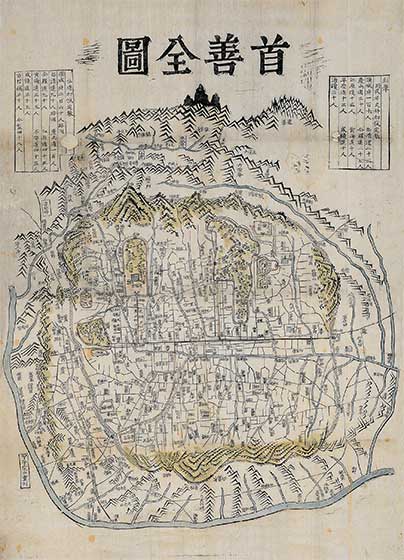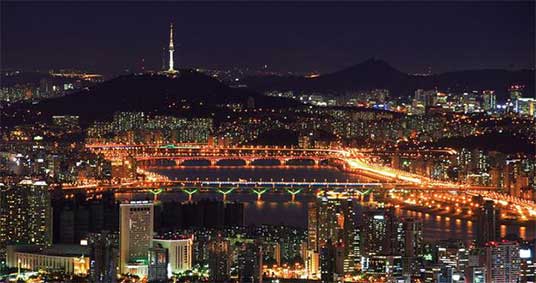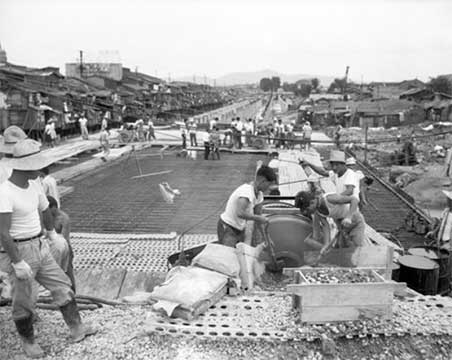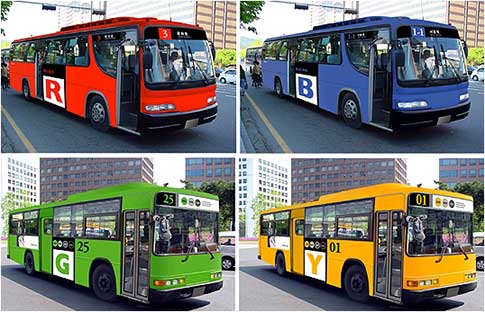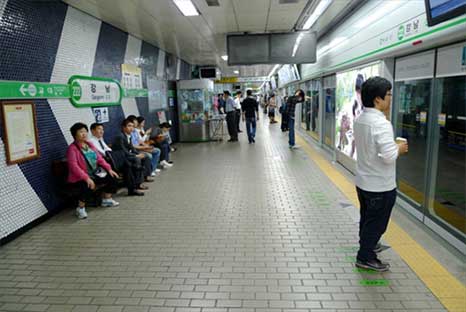
Seoul
Seoul (English pronunciation: /soʊl/; Korean: [sə.ul] ( listen) — officially the Seoul Special City — is the capital and largest metropolis of South Korea. A megacity with a population of more than 10 million, it is the largest city proper in the developed world.The Seoul Capital Area, which includes the surrounding Incheon metropolis and Gyeonggi province, is the world's second largest metropolitan area with over 25.6 million people,home to over half of South Koreans along with 632,000 international residents.
Situated on the Han River, Seoul's history stretches back more than 2,000 years when it was founded in 18 BC by Baekje, one of the Three Kingdoms of Korea. It continued as the capital of Korea under the Joseon Dynasty and the Korean Empire. The Seoul metropolitan area contains four UNESCO World Heritage Sites: Changdeok Palace, Hwaseong Fortress, Jongmyo Shrine and the Royal Tombs of the Joseon Dynasty.Seoul is surrounded by mountains, the tallest being Mt. Bukhan, the world's most visited national park per square foot.Modern landmarks include the iconic N Seoul Tower, Lotte World, the world's second largest indoor theme park,and Moonlight Rainbow Fountain, the world's longest bridge fountain.The birthplace of K-pop and the Korean Wave, Seoul was voted the world's most wanted travel destination by Chinese, Japanese and Thai tourists for three consecutive years in 2009–2011 with over 10 million international visitors in 2012.
Today, Seoul is considered a leading and rapidly rising global city, resulting from an economic boom and growth known as the Miracle on the Han River which transformed it from the ashes of the Korean War to the world's fourth largest metropolitan economy with a GDP of US$773.9 billion in 2012 after Tokyo, New York City and Los Angeles. A world leading technology hub,it boasts the world's sixth largest number of Fortune Global 500 multinationals such as Samsung, the world's largest technology company, as well as LG, SK, and Hyundai-Kia. Gangnam is the commercial center along with Yeoui Island forming the financial center and Digital Media City being the technology hub. Jongno and Central District are the historical and cultural center of Seoul. Ranked sixth in the Global Power City Index, the metropolis exerts a major influence among global affairs as one of the five leading hosts of global conferences.It is one of the world's most livable major cities, with the United Nations rating Seoul's quality of life higher than New York City, London or Melbourne in 2012.
Seoul has a very technologically advanced infrastructure.It has the world's highest fibre-optic broadband penetration, resulting in the world's fastest internet connections with speeds up to 1 Gbps.Seoul Station is the main terminal of the KTX high-speed rail and the Seoul Subway is the world's largest subway network by length,considered the world's best subway by Jalopnik eaturing 4G LTE, WiFi, DMB and WiBro. Seoul is connected via AREX to Incheon International Airport, rated the world's best airport seven years in a row (2005–2012) by Airports Council International.Lotte World Tower, a 556m (1,824 ft) supertall skyscraper is under construction in Seoul to become the OECD's tallest in 2015 with the world's tallest observation deck on its 123rd floor.
Seoul hosted the 1986 Asian Games, 1988 Summer Olympics, 2002 FIFA World Cup and the 2010 G-20 Seoul summit. A UNESCO City of Design, Seoul was named the 2010 World Design Capital.
History
Seoul is first recorded as Wiryeseong, the capital of Baekje from its legendary founding in 18 BC. It was known as Hanseong (漢城, "fortified city [on] the Han [River]") during the Goryeo period. During the Joseon period, beginning in 1394, it was the capital, called Hanyang (漢陽)). It was called Gyeongseong (京城, Japanese: Keijō) during the Japanese occupation, and finally named Seoul after the 1945 liberation.
Donuimun, the west gate of Seoul, as painted in 1910. It was demolished in 1915 by Imperial Japan. Baekje, one of the Three Kingdoms of Korea, was founded in 18 BC, with its capital at Wiryeseong in the Seoul area. There are several city walls remain in the area dating from this time, and Pungnap Toseong, an earthen wall just outside Seoul, is widely believed to be the main Wiryeseong site. As the Three Kingdoms competed for this strategic region, control passed from Baekje to Goguryeo in the 5th century, and from Goguryeo to Silla in the 6th century.
In the 11th century Goryeo, which succeeded Unified Silla, built a palace in Seoul, which was referred to as the "Southern Capital". When Joseon replaced Goryeo, the capital was moved to Seoul (also known as Hanyang and later as Hanseong), where it remained until the fall of the dynasty.
Originally, the city was entirely surrounded by a massive circular wall (a 20-foot-high circular stone fortress) to provide its citizens security from wild animals such as the tiger, thieves and attacks. The city has grown beyond those walls and although the wall no longer stands (except in the mountains north of the downtown area), the gates remain near the downtown district of Seoul, including most notably Sungnyemun (commonly known as Namdaemun) and Honginjimun (commonly known as Dongdaemun). During the Joseon dynasty, the gates were opened and closed each day, accompanied by the ringing of large bells.
In the late 19th century, after hundreds of years of isolation, Seoul opened its gates to foreigners and began to modernize. Seoul became the first city in East Asia to have electricity, trolley cars, water, telephone, and telegraph systems all at the same time. Much of this was due to trade with foreign countries like France and United States. For example, the Seoul Electric Company, Seoul Electric Trolley Company, and Seoul Fresh Spring Water Company were all joint Korean-American owned enterprises. In 1904, an American by the name of Angus Hamilton visited the city and said, "The streets of Seoul are magnificent, spacious, clean, admirably made and well-drained. The narrow, dirty lanes have been widened, gutters have been covered, roadways broadened. Seoul is within measurable distance of becoming the highest, most interesting and cleanest city in the East.”
After the Russo-Japanese War (1904-1905), the Empire of Japan annexed Korea and renamed the city "Keijo". The city was liberated at the end of World War II. During the Korean War, Seoul changed hands between the Chinese-backed North Korean forces and the UN-backed South Korean forces several times, leaving the city heavily damaged after the war. One estimate of the extensive damage states that after the war, at least 191,000 buildings, 55,000 houses, and 1,000 factories lay in ruins. In addition, a flood of refugees had entered Seoul during the war, swelling the population of Seoul and its metropolitan area to an estimated 2.5 million, more than half of them homeless.
Following the war, Seoul was the focus of an immense reconstruction and modernization effort due mainly to necessity, but also due in part to the symbolic nature of Seoul as the political and economic centre of Korea. In 1963, the size of Seoul administrative area greatly expanded as it annexed a number of towns and villages from several surrounding counties in Gyeonggi Province, such as Bucheon, Siheung, Gwangju, Yangju, and Gimpo. Today, the population of the Seoul area makes up 24% of the total population of South Korea, and Seoul ranks seventh in the world in terms of the number of Fortune 500 transnational companies headquartered there. Seoul was the host city of the 1988 Summer Olympics as well as one of the venues of the Football World Cup 2002.
Transportation
Bus
Seoul's bus system is operated by the Seoul Metropolitan Government, with four primary bus configurations available servicing most of the city. Seoul has many large intercity/express bus terminals. These buses connect Seoul with cities throughout South Korea. The Seoul Express Bus Terminal, Central City Terminal and Seoul Nambu Terminal are located in the district of Seocho District. In addition, East Seoul Bus Terminal in Gwangjin District and Sangbong Terminal in Jungnang District operate in the east of the city. To reduce air pollution in the metropolitan area, the municipal government is planning to convert over seven thousand of Seoul's diesel engine buses to natural gas by 2010.
Subway
Seoul has a comprehensive subway network that interconnects every district of the city and the surrounding areas. With more than 8 million passengers per day, Seoul has the busiest subway system in the world. The Seoul Metropolitan Subway has 18 total lines which serve Seoul, Incheon, Gyeonggi province, western Gangwon province, and northern Chungnam province. In addition, in order to cope with the various modes of transport, Seoul's metropolitan government employs several mathematicians to coordinate the subway, bus, and traffic schedules into one timetable. The various lines are run by Korail, Seoul Metro, Seoul Metropolitan Rapid Transit Corporation, NeoTrans Co., AREX, and Seoul Metro Line 9 Corporation.

